Aggregate Function Reference
All standard aggregate functions and available modifiers are listed on this page.
An aggregate function call contains an expression in curly braces ("{}"), which is calculated for the item and all sub-items (or, in some cases, for another subset of related items in the structure), and then the resulting values are aggregated according to the meaning of the aggregate function.
Aggregation Functions
Produces an array of the defined values for the item and/or its sub-items.

Accepts modifiers: #ancestors, #children, #leaves, #strict, #subtree, #fromLevel, #toLevel, #reverse, #distinct (does not include duplicate values), #flatten (if function produces an array, includes the inner values, rather than the array), #compact
Avg calculates an average of the defined values for the item and/or its sub-items. The result for avg is generally the same as sum/count. It returns nothing if there are no defined values for {x}.

If a certain issue (or another kind of item) is included multiple times in the sub-tree, the average value will include the value for that issue only once. This behavior can be overridden by using the #all modifier.
Accepts modifiers: #all, #children, #leaves, #strict, #subtree, #preceding, #levels (together with #preceding), #baseLevel (together with #preceding).
Count calculates a count of defined values (or truthy values, if the #truthy modifier is specified) for the item and/or its sub-items.

If a certain issue (or another kind of item) is included multiple times in the sub-tree, it will be counted only once. This behavior can be overridden by using the #all modifier.
Accepts modifiers: #all, #children, #leaves, #level, #strict, #subtree, #truthy, #preceding, #levels (together with #preceding), #baseLevel (together with #preceding).
Returns true if the current row is an issue and it matches this JQL.

This is not an aggregate function; it's an embedded query. We've included it here because it's easy to mistake for an aggregate function - both use curly braces { }.
To learn more, see Embedded Queries.
Join concatenates (joins) strings from the item and its parents (or other items, if modifiers are used).
- By default, it joins all parent string values from root to the self value.
- If the current row has children and the #subtree modifier is set, join appends the values for children, wrapping them into characters (braces by default).
- Wrapping characters can be set by #beforeChildren and #afterChildren (see example for #subtree to see how it works).

Accepts modifiers: #ancestors, #subtree, #children, #leaves, #strict, #reverse, #separator, #beforeChildren, #afterChildren, #fromLevel, #toLevel, #distinct.
Max returns the maximum defined value for the item and/or its sub-items. Numeric, date, duration and text fields can be compared. Text fields are compared lexicographically.

If the formula produces an array, this will find the maximum element within that array.
Produces the median value. Works the same as PERCENTILE#0.5.
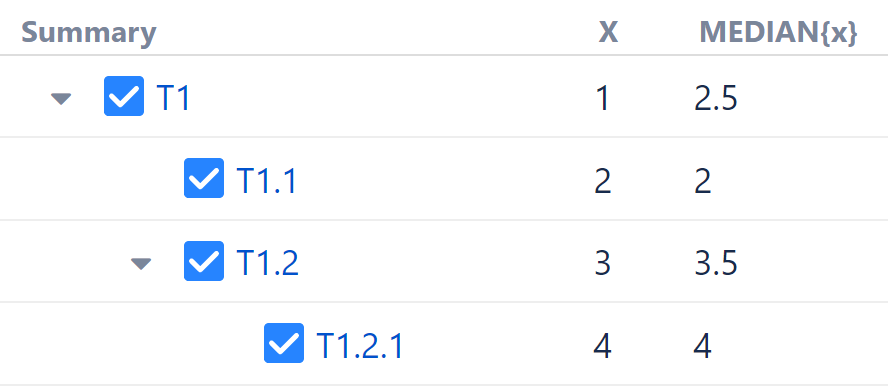
Undefined are ignored. Non-number values result in an error.
Accepts modifiers: #ancestors, #children, #leaves, #strict, #subtree, #fromLevel, #toLevel
Min returns the minimum defined value for the item and/or its sub-items. Numeric, date, duration and text fields can be compared. Text fields are compared lexicographically.

If the formula produces an array, this will find the minimum element within that array.
Parent extracts the value from the parent row or from an ancestor row by a specified level.

Using the #level modifier, you can specify which row to extract the value from:
PARENT#level=-1{}extracts the value from the parent row (same asPARENT{})PARENT#level=-2{}extracts the value from the grandparent rowPARENT#level=1{}extracts the value from the root row
Accepts modifier: #level.
Calculates a percentile value from the defined values for the item and/or its sub-items. The hierarchy of values is ignored – all subject values are treated equally.
Must include the modifier #p, followed by the desired percentile (p=0.95, p=95). p=1 interpreted as 1%.
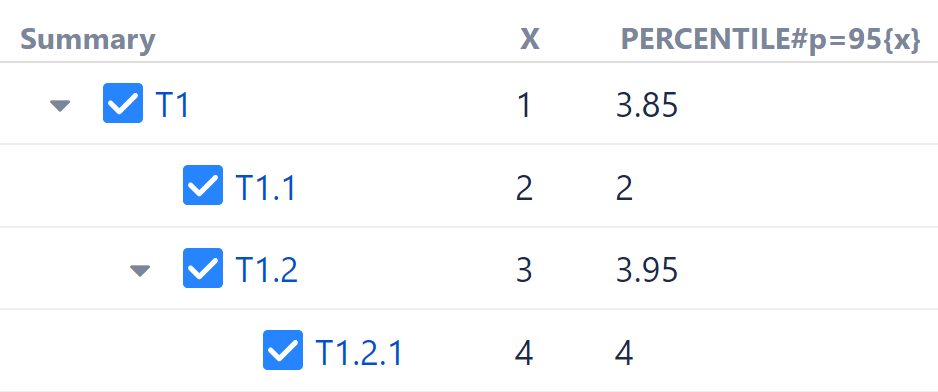
Undefined are ignored. Non-number values result in an error.
Accepts modifiers: #ancestors, #children, #leaves, #strict, #subtree, #fromLevel, #toLevel, #p (required)
Works the same as PERCENTILE#0.25.
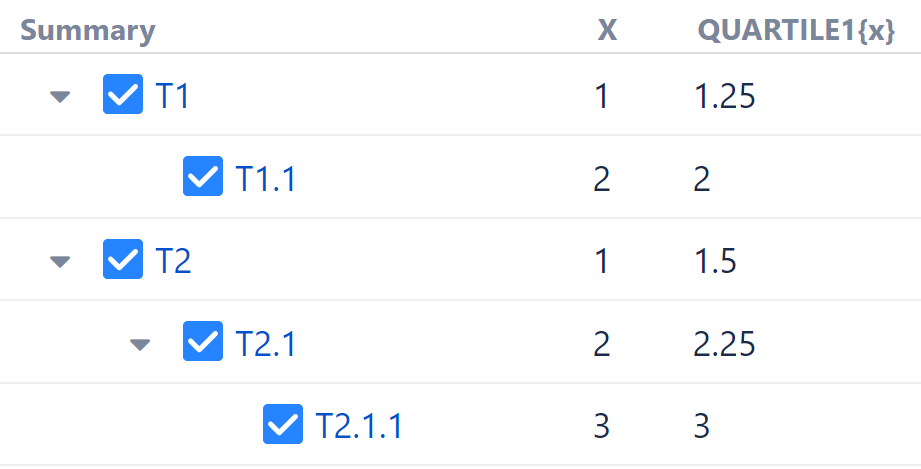
Undefined are ignored. Non-number values result in an error.
Accepts modifiers: #ancestors, #children, #leaves, #strict, #subtree, #fromLevel, #toLevel
Works the same as PERCENTILE#0.75.

Undefined are ignored. Non-number values result in an error.
Accepts modifiers: #ancestors, #children, #leaves, #strict, #subtree, #fromLevel, #toLevel
Returns true if the current row matches this S-JQL.
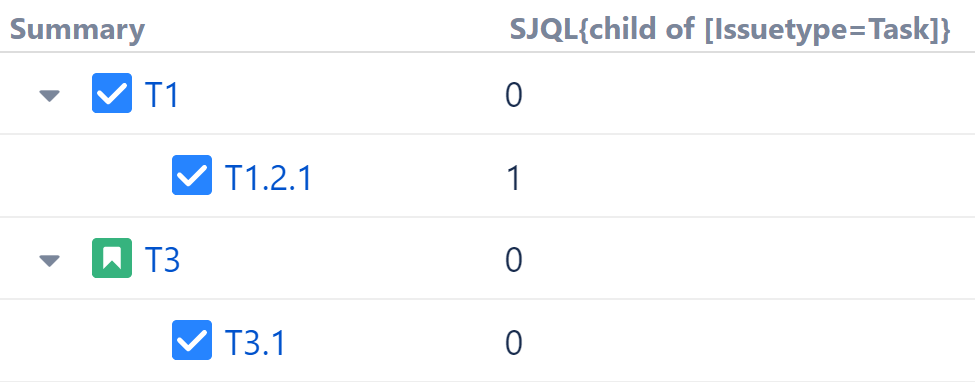
This is not an aggregate function; it's an embedded query. We've included it here because it's easy to mistake for an aggregate function - both use curly braces { }.
To learn more, see Embedded Queries.
Sum calculates a numerical total for the values calculated for the item and/or its sub-items.

Other variations of SUM allow different types of aggregation:
SUM{}(the same asSUM#subtree{}) aggregates values from all descendantsSUM#children{}aggregates values from direct children onlySUM#leaves{}aggregates values from leavesSUM#preceding{}aggregates values from the preceding rows- If the formula produces an array, calculates the total of the elements of that array
Note that when the value of the expression under aggregation is not numeric (and cannot be converted to a number), it is ignored.
If a certain issue (or another kind of item) is included multiple times in the sub-tree, the sum will include the value for that issue only once. This behavior can be overridden by using the #all modifier.
Accepts modifiers: #all, #children, Aggregate Function Reference##leaves, #level, #level, #preceding, #strict, #subtree, #levels (together with #preceding), #baseLevel (together with #preceding).
Produces an array of all distinct values for the item and/or its sub-items.

If a value is an array, considers each value in the array separately.
Accepts modifiers: #ancestors, #children, #leaves, #strict, #subtree, #fromLevel, #toLevel
Aggregation Modifiers
Defines the exit separator between children and parent rows. This modifier has a string parameter. The default exit separator is:
- "(" - for #beforeChildren
- ")" - for #afterChildren
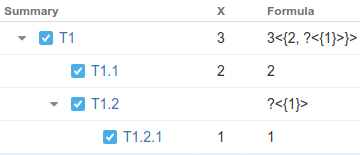
CODE
|
Can be used with: join.
Can be used with SUM with the #preceding modifier to specify at which level the accumulation will be reset and start over from zero. This allows for accruing independent cumulative values in different sub-trees.
- By default, baseLevel is 0, which means that the accumulation will never start over and will cover the whole structure.
- If baseLevel is not zero, then the accumulation will be restarted once it reaches a row at the base level or higher in the hierarchy. For example, if you have epics at the top level, and stories underneath them,
SUM#preceding#baseLevel=1{story_points}will accumulate the Story Points within the scope of each epic independently.
Can be used with: avg, count, sum (together with #preceding).
See #afterChildren.
Same as #level modifier, except #depth cannot be used with SUM, COUNT, or AVG.
#distinct with ARRAY
Makes array only produce an array of distinct values. A duplicate value won't be added more than once if this modifier is on.
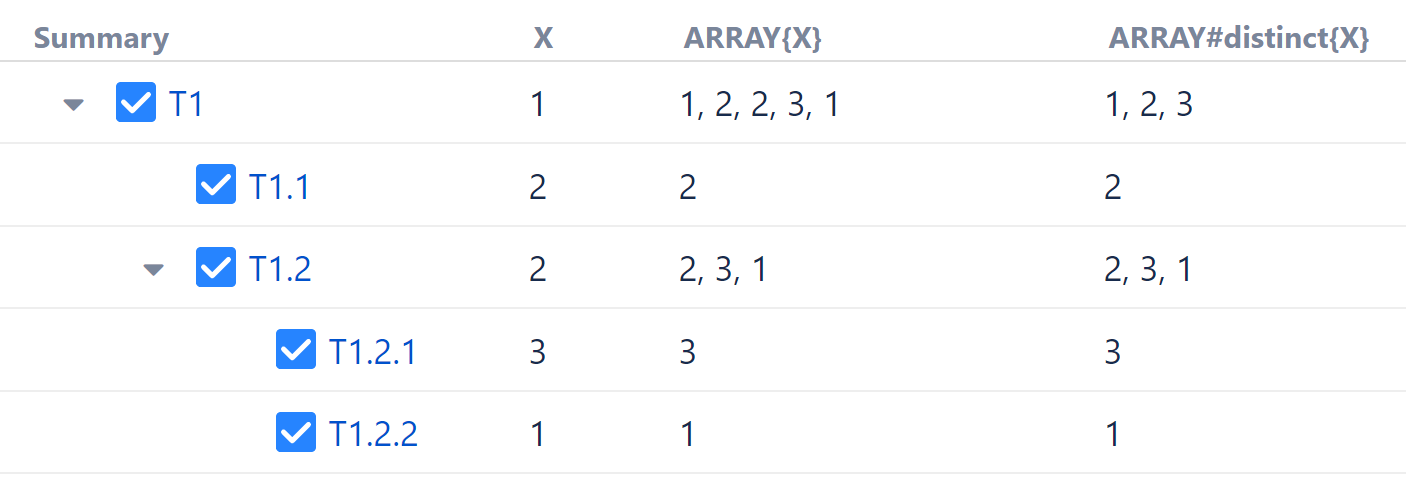
CODE
|
#distinct with JOIN
Makes join only concatenate distinct values. A duplicate value won't be added more than once if this modifier is on. When used with arrays, removes undefined values and performs one-step flattening.
Modifiers #beforeChildren and #afterChildren don't work when this option is on.

CODE
|

CODE
|
Can be used with: join.
Specifies the position of the first row the aggregate function should take as input for a sequence.
Position is specified by an integer parameter denoted as n below:
- Positive values mean the absolute depth of the row in the structure, e.g. n=1 means root.
- Negative values mean the depth relative to current row, e.g. n=-1 is the current item's direct parent.
- Default is 1.
- Zero means the "super-root" row, which is a fictional parent of all the top rows. It can be used to get the value of another aggregate function applied to the whole structure. For example,
JOIN#fromLevel=0{MIN{due_date}}will provide a sequence of the earliest due dates, starting from the earliest throughout the whole structure, then the earliest throughout the root tree this item is in, and so on.
This modifier does not work with any tree types except #ancestors.

CODE
|
Can be used with: array, join, median, percentile, quartile1, quartile3, values.
When used with PARENT, specifies the position of the parent that possesses value.
Position is specified by an integer parameter denoted as n below:
- Positive values mean the absolute depth of the row in the structure: n=1 means root element, n=2 means an element at the 2nd level, etc.
- Negative values mean the depth relative to the current row: n=-1 is the current item's direct parent.
- Default is -1.
- Zero means the "super-root" row, which is a fictional parent of all the top rows. It can be used to get the value of another aggregate function applied to the whole structure. For example,
PARENT#level=0{SUM{story_points}}means total story points for the whole structure (including subtrees for all roots).
When used with SUM with the #preceding modifier, this specifies the level at which the values should be aggregated.

CODE
|
Can be used with: parent, sum (together with #preceding), count (together with #preceding), avg (together with #preceding).
Can be used with SUM with the #preceding modifier to specify at which levels should the accrual of the values happen.
- It can be a single numeric value, for example:
SUM#preceding#levels=1{story_points}will accumulate Story Points from top to bottom at level 1. - It can be a list of numbers, in which case the list must be wrapped in quotes:
SUM#preceding#levels="2,4"{time_spent}will accumulate Time Spent on levels 2 and 4. - By default, all levels are counted.
Note that if you use the #baseLevel modifier, only values at levels that are deeper than the base level will be counted.
You can also use #level instead of #levels.
Can be used with: avg, count, sum (together with #preceding).
Can be used with SUM to calculate a numeric total of the current item and all items above it in the structure.
Can be combined with the following modifiers:
- #baseLevel - the sum restarts whenever the specified level is reached
- #levels - the sum will only include the levels specified
- #all - items that appear more than once will be counted multiple times
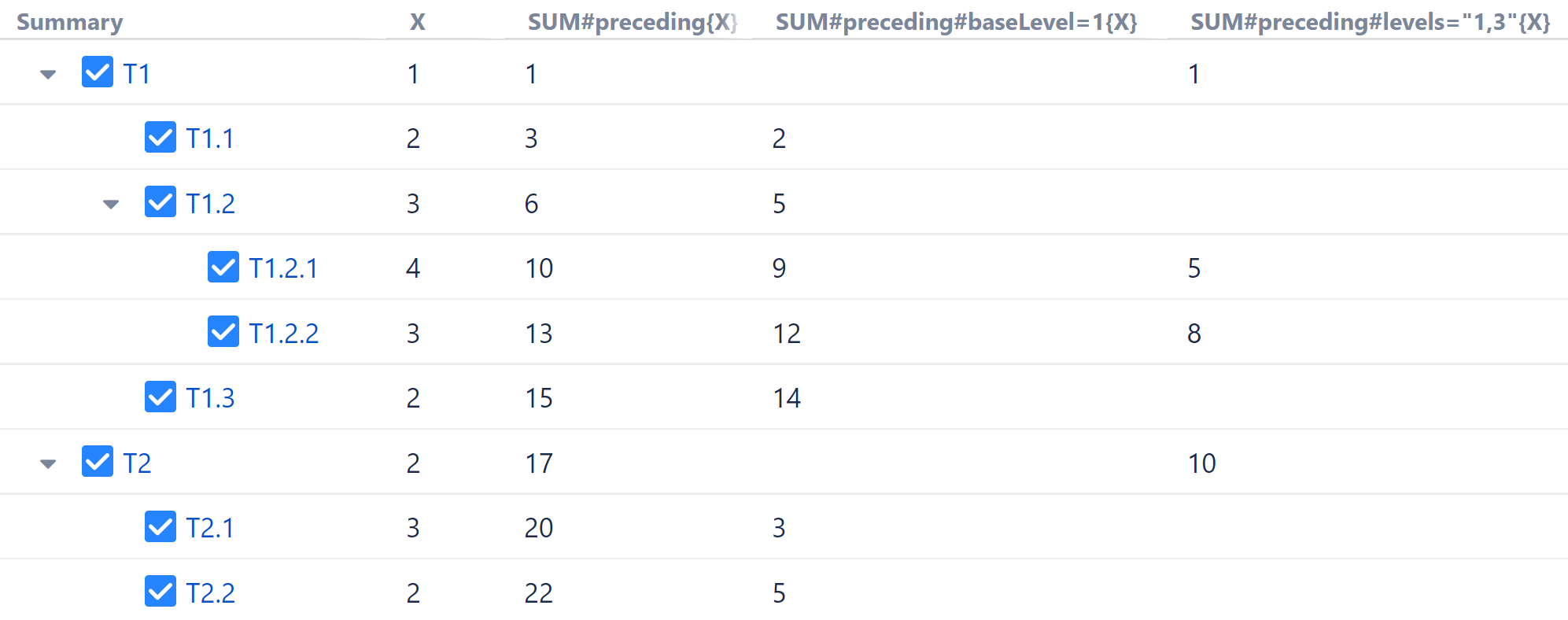
CODE
|
Defines the separator for string joining. This modifier has a string parameter. The default is ", ".

CODE
|
Can be used with: join.
Do not process the current row item as part of the aggregation.
Cannot be used together with #children, #ancestors or #leaves, since these already exclude the current row.

CODE
|
Can be used with: array, sum, count, avg, join, min, max, median, percentile, quartile1, quartile3, values.
Same as #toLevel, except #toDepth cannot be used with MEDIAN, PERCENTILE, QUARTILE1, or QUARTILE3.
Specifies the position of the last row the aggregate function should take as input for a sequence.
Position is specified by an integer parameter denoted as n below:
- Positive values mean the absolute depth of row in the structure, e.g. n=1 means root.
- Negative values mean the depth relative to current row, e.g. n=-1 is the current item's direct parent.
- 0 means current row.
- Default is 0.
This modifier does not work with any tree types except #ancestors.

CODE
|
Can be used with: array, join, median, percentile, quartile1, quartile3, values.
Only count row if the subexpression produces a truthy value .

CODE
|
Can be used with: count.




